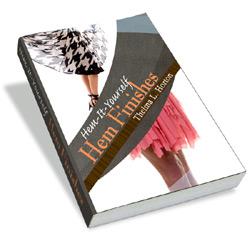Fashion Sewing
Tips
Avoid
time-consuming guesswork when
selecting the perfect outfit to sew.
Simplify the process by applying the same fashion rules for purchasing
ready-to-wear clothes. Ill-fitting clothes are a fashion no-no,
whether it’s pants that are too long, skirts that are too
tight
or jackets that are too short.
The keys
to sewing a flattering garment
that you will love and wear forever is great style and fit. Trying on
clothes can help you determine if you are making a wise investment of
your time and money.
One way to
accomplishment this is to take advantage
of ready-to-wear clothes by setting aside time for shopping days.
This gives you an
opportunity to take note of current trends in the stores. Making a
garment without trying on a similar style in ready-to-wear is gambling
with both time and money.
You want to
avoid the frustration
and the hours used wrestling with an unworkable pattern, as well as
expensive fabric wasted on a garment that just wouldn’t come
together.
Also keep up with
the latest fashion magazines.
Most home sewers
do not like to shop, therefore, may not be aware of what styles and
fabrics are flattering to the figure, and unaware of the latest
trends.
Set aside two full
days a year, one in spring and
one in fall, to do nothing but try on clothes from ready-to-wear.
-
Record
in a notebook flattering and unflattering styles.
-
Pay
special attention to
silhouettes, sleeve styling, seamlines, skirt and jacket lengths, as
well as styling details that could be incorporated into your sewing.
Addition of these details often makes the difference between an
ordinary and extraordinary garment.
-
Observe
fabric and style
combinations and why they work. Designers pretest numerous fabrics
before coming up with a salable item. Try to learn from their
successes.
-
Carry
a 6" ruler, and use it
to measure cuffs, collars, belts, plackets, pockets, or anything else
you find that makes the style interesting.
-
Measure
garments that you
love and fit well, and then look for a pattern with similar
measurements (at bust, waist, hip, and shoulder width, as well as
garment length and hem width). Look also for the words “loose
fitting” in the pattern description on back of the envelope.
-
If
a style is flattering and
the fabric is not, try to figure out what you don’t like
about
the fabric and look for alternatives.
-
Look
for fabrics that have a flattering drape, feel comfortable, and do not
wrinkle.
-
Pay
attention to accessories, including buttons. They give the
final touch to the outfit and
pull the whole look together.
Do not attempt to
go pattern and fabric shopping on the same day you shop
ready-to-wear.
You will probably be exhausted from information
overload. Take a break to give you an opportunity to absorb
the
information and take notes for later reference.
When the pattern
search begins, pattern purchases will no longer be impulsive. You will
know the current trends and what looks best on you. Study the line
drawings on the pattern envelope. Look for style lines similar to those
in ready-to-wear that you found flattering on you.
Applying this
little fashion
tip makes a hugh difference between the homemade look and the
professional store bought look.
-
If
you are slightly
overweight, any pattern with horizontal seamlines will make you look
heavier. Look for vertical and asymmetrical style lines that can divide
the silhouette and keep the eye moving up and down rather than across.
If the pattern is described as “very loose
fitting,”
consider buying it one size smaller to eliminate some of the style
ease, scaling down the “big” look.
-
If
you have broad shoulders
or a large bust, a wide yoke will only draw attention to the problem.
Raglan sleeves and boat necklines do not flatter narrow sloping
shoulders.
-
If
your tummy is not flat,
pleats and soft gathers will be kinder to your figure than tailored
pants or a front yoke. Study the neckline and sleeve styling carefully.
Would this pattern be more flattering on you with a neckline from
another pattern? These things can be changed by overlaying one pattern
on another. An unflattering or uncomfortable neckline may be the sole
reason a garment hangs unworn in the closet.
-
Try
to visualize yourself in the garment and ask yourself:
-
Is
this style really me?
-
Where
will I wear this?
If you cannot think
of enough occasions where you would feel comfortable in this garment,
it is unlikely you will change your mind when the garment is completed.
Step-by-step
instructions on how to apply these
fashion sewing tips to your sewing projects are found in my popular learn
how to sew ebook, "Sew-It-Like a Pro"
For
a limited time you can download
And
2 FREE Bonus Books
 
for
the incredibly low price of $27 and have it downloaded
to your computer in seconds!
BUY
THEM NOW
|






